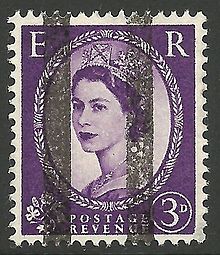The Wildings were a series of definitive postage and revenue stamps featuring the Dorothy Wilding photographic portrait of Queen Elizabeth II that were in use between 1952 and 1971. The Wildings were the first and only British stamps to feature graphite lines on the back, and the first to feature phosphor bands on the face – both aids to automation. The stamps were also the first British pictorial high value stamps and the first to include regional emblems.
Design history
The stamps reproduced a portrait of Queen Elizabeth II taken during a photographic session on 26 February 1952 by Dorothy Wilding, who had been working at the Royal Court since 1937. Seventy five designs were considered to frame the portrait and five basic designs by Edmund Dulac, Enid Marx, Mary Adshead, Michael Farrar-Bell and George Knipe were selected. Four symbolic flowers of each country of the United Kingdom were also depicted, imitating one of the definitive stamp designs of King George VI's reign.
Dorothy Wilding's photograph depicts The Queen wearing the State Diadem made for George IV in the 1820s, which was designed to be worn outside a Cap of Maintenance. This diadem was also worn by Queen Victoria on stamps such as the Penny Black. The original photograph was re-touched to bring the diadem further forward on the Queen's head.
The replacement of the Wildings was initiated by stamp designers Michael Goaman and Faith Jacques. In a letter sent to the Post Office in April 1961, they expressed the difficulty of including the large Wilding portrait in their designs for commemorative stamps and the fact that the Queen was half turned to the viewer was also felt to be unsatisfactory. They proposed an image that would represent the monarchy more than the person of the queen. In 1963, comparing the Wilding portrait with Jacques' proposed design, the Stamp Advisory Committee acknowledged the need for a replacement, and in 1967 the stamps were replaced by the Machin head though the design continued to be used for regional issues until decimalization in 1971.
Low values

Eighteen values – in 1⁄2d increments up to 3d, 1d increments (plus 41⁄2d) up to 1s, 1s 3d and 1s 6d – were issued starting with the 11⁄2d and 21⁄2d on 5 December 1952. All were printed in photogravure by Harrison and all were perforated 15 (more accurately 143⁄4) × 14.Three separate watermarks were used:
- Tudor crown + E2R (1952 to 1954)
- St. Edward's crown + E2R (1955 to 1958)
- St. Edward's crown (1958 on)
For brevity these are known as 'Tudor Crown', 'St. Edward's Crown' and 'Crowns' (or 'Multiple crown') respectively. The Tudor crown watermark was replaced because the dandy roll was worn, and the St. Edward's Crown watermark was replaced because of the introduction of Scottish regional issues and perceived sensitivities as Elizabeth was the first Elizabeth to rule Scotland not the second.
As well as the normal upright watermark – on values up to and including 4d – the stamps are also found with inverted, sideways and sideways inverted watermarks from booklets and coils.
The original cream paper was changed to white from April 1962 resulting in two variants of the 'crowns' watermark stamps. The 6d is also sometimes found on slightly pinkish paper.
Several of the values are found in a variety of shades, the most obvious being a red brown and a dark red brown for the 2d and two distinct blues for the 4d. There are also two distinct dies of the 21⁄2d red, easily distinguished by the outlining of the central gem on the Queen's crown.